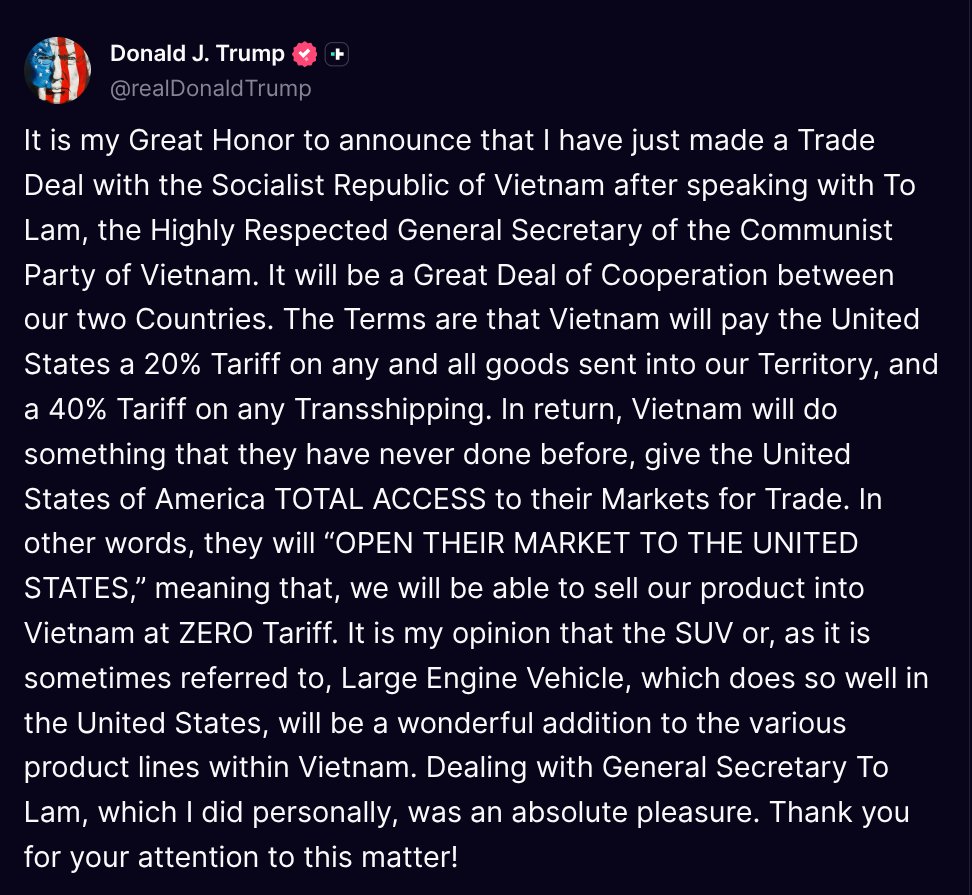President Trump on Wednesday announced a trade deal between the United States and Vietnam, saying “Vietnam will pay the United States a 20% Tariff on any and all goods sent into our Territory, and a 40% Tariff on any Transshipping.”
“It is my Great Honor to announce that I have just made a Trade Deal with the Socialist Republic of Vietnam after speaking with To Lam, the Highly Respected General Secretary of the Communist Party of Vietnam. It will be a Great Deal of Cooperation between our two Countries. The Terms are that Vietnam will pay the United States a 20% Tariff on any and all goods sent into our Territory, and a 40% Tariff on any Transshipping,” Trump said on Truth Social.
“In return, Vietnam will do something that they have never done before, give the United States of America TOTAL ACCESS to their Markets for Trade. In other words, they will ‘OPEN THEIR MARKET TO THE UNITED STATES,’ meaning that, we will be able to sell our product into Vietnam at ZERO Tariff. It is my opinion that the SUV or, as it is sometimes referred to, Large Engine Vehicle, which does so well in the United States, will be a wonderful addition to the various product lines within Vietnam,” he continued.
“Dealing with General Secretary To Lam, which I did personally, was an absolute pleasure. Thank you for your attention to this matter!” he added.
CNBC noted:
The process, known as transshipping, is used to circumvent trade barriers. China, a top exporter to the U.S., has reportedly used Vietnam as a transshipment hub.
ADVERTISEMENTTrump wrote that “Vietnam will pay” that 20% duty, but tariffs are taxes on foreign goods that are paid by the importers of those products.
The agreement was unveiled less than a week before a 90-day pause on many of Trump’s so-called reciprocal tariffs was set to expire, sending U.S. duties on imports from dozens of countries soaring.
Under that protectionist trade scheme, Vietnamese imports to the U.S. were subject to a 46% blanket tariff.
The S&P 500 rose slightly on news of the trade deal. But apparel companies that rely on Vietnam’s manufacturing capacity could face higher import costs under the new tariff rate.
The Trump administration set a July 9th deadline for the pause on reciprocal tariffs.
According to CNN, the announced deal with Vietnam is the third significant agreement before the looming deadline.
India is reportedly close to a deal in the coming days.
Check it out:
"Staffers on these deals … can't believe what we're getting": @SecScottBessent reveals U.S. is close to a trade deal with India pic.twitter.com/fdVbqjibqD
— FOX & Friends (@foxandfriends) July 1, 2025
More details on the Vietnam deal from CNN:
It wasn’t immediately clear if the deal was finalized or whether Vietnam had agreed to what Trump announced. Vietnam’s state-run news outlet, Việt Nam News, reported that General Secretary Tô Lâm and Trump spoke on the phone Wednesday to patch up the terms of the deal, which it referred to as a framework.
ADVERTISEMENTOn the call, “Lâm proposed that the US soon recognize Việt Nam as a market economy and lift export restrictions on certain high-tech products,” the outlet reported.
For months, Trump and his administration have been saying countries were lining up to make trade deals with the United States. But, ahead of July 9, when the 90-day pause on “reciprocal” tariffs ends and levies as high as 50% could go into effect, it’s been mostly crickets. Restoring those historic tariffs risks rocking financial markets and businesses’ plans alike.
Tariff rates on Vietnamese goods shipped to the US were set to rise to a minimum of 46% if the rates Trump announced in April held. Tariffs on Vietnam were among the highest he announced.
Vietnam was the sixth-top source of goods the US imported last year, shipping $137 billion worth of goods. That’s more than double the value of goods exported to the US five years prior, according to US Commerce Department data.
Meanwhile, the trade deficit with Vietnam, equal to the value of goods the US exports there minus imports, has risen in tandem. Last year, it was $123 billion, the third-largest trade deficit the US had with any country. Back in 2019 it was $56 billion, the fifth-largest trade deficit with another country.
Trump has taken particular issue with countries that run large and persistent trade deficits with the US, claiming they’re indicative of unfair trade practices. That helps explain why he sought to impose one of the highest “reciprocal” tariff rates on the country.
Source link


